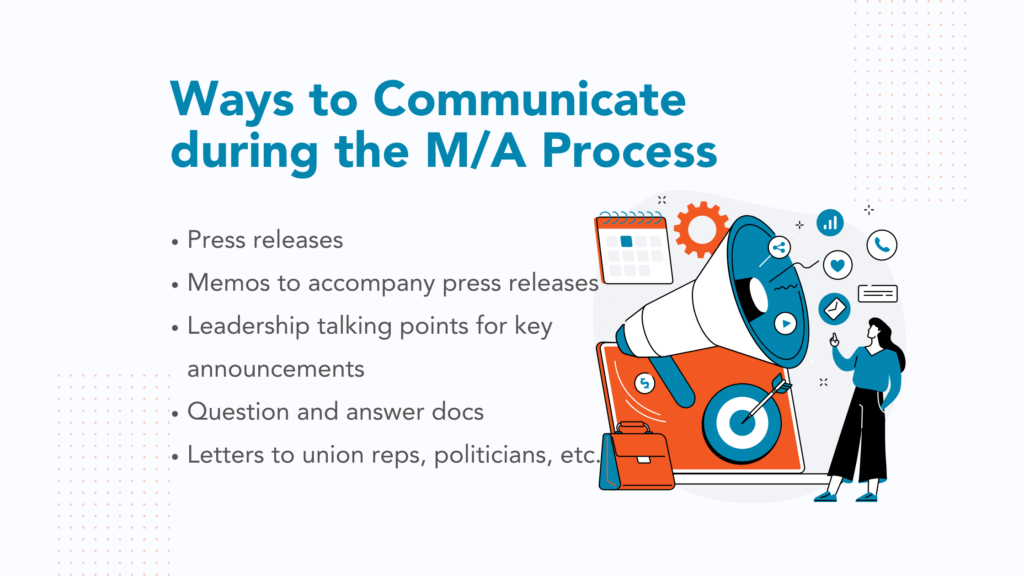Acquiring a new business is simultaneously exciting and challenging. Mergers and acquisitions move fast, bringing in new developments daily, if not hourly. Expectations and truths toward the future can shift with each new learned fact, and delivering those moment-to-moment “truths” become burdensome and ultimately, add to the confusion. However, when communication is on key and all partners in the acquisition are turning that key at the same time, beautiful things can happen. Allies can be made, resources can be shared, and a unified, elevated outcome can be achieved.
Communications Struggles during the Merger and Acquisition Process
Acquiring companies face a number of communications challenges when it comes to adding to their portfolio. Human behavior translates stress into hearsay, which then morphs into misinterpretation, exaggeration, and miscommunication. These tendencies are why a strong, strategic communications strategy is so important to the first stages of acquisition. The more timely, clear, and confident your messaging, the less weight the fears and rumors have.
While not every fear and misunderstanding will ever be quashed during an M&A transition, a well-crafted communications plan will ensure a smooth transition, protect the acquirer’s credibility, minimize disruptions, and promote positive relationships between employees, stakeholders, and customers.
According to the mid-year Ernest & Young CEO Outlook Pulse survey, nearly all (98%) of CEOs expect to pursue a strategic transaction in the next 12 months – up 10% from January of this year. Communication is the key to proceeding and succeeding – so let’s take a look at the key principles to crafting effective communications strategy during the M&A process.
Key Principles to Effective Internal M&A Communications
Establish clear goals and objectives: The first step in effective communication is to establish clear goals and objectives for the acquisition or merger. This will help ensure that everyone is on the same page and working towards the same end goal.
Communicate openly and honestly: Be transparent about the reasons for the acquisition or merger and the expectations for the future. Employees will appreciate knowing what to expect, and it can help prevent rumors and misunderstandings from spreading.
Listen to feedback: Encourage open and honest feedback from employees and stakeholders. This will help you identify any potential roadblocks or areas of concern and make adjustments as needed.
Provide regular updates: Regular updates are important to keep everyone informed and involved. Make sure to communicate updates on the progress of the acquisition or merger and any relevant changes or decisions that have been made.
Address concerns: Address any concerns or questions that stakeholders may have. This can help alleviate anxiety and increase engagement and commitment.
Foster a culture of open communication: Encourage employees and partners to communicate openly and honestly, and provide a safe space for them to do so. This can help to foster a culture of trust and collaboration, which is critical for the success of an acquisition or merger.
Provide training and support: Provide training and support for employees to help them adapt to any changes that may come with the acquisition or merger. This can help ensure a smooth transition and minimize disruptions to day-to-day operations.
Evaluate and adjust: Finally, regularly evaluate the effectiveness of your communication plan and make adjustments as necessary. This may include refining your messages, using different channels, or adjusting the timing of your communications.
Key Internal Messages to Convey during the Acquisition Process
A well-crafted communication plan can help reduce employee anxiety and cynicism, protect the acquirer’s credibility, and prevent top management from being accused of reneging on its promises. Key messages to include during the M&A process include:
- This M&A will create a new organization featuring the best of both brands.
- Customers will enjoy a strong and complementary product mix.
- The merger is not a take-over; it’s the creation of a stronger combined company.
- The potential for revenue and cost synergies is high.
- There is overlap between the companies, and therefore redundancies – we are working to determine the best solutions.
- Our timeline is this but is expected to adapt and change as new information presents itself.
Ways to Communicate Key Messages during a Merger or Acquisition
Consider your audience when developing your communications strategy. Some members of the team will respond better to emails, while opportunities to present points via leadership talks always prove valuable.

The Goal is Clarity
Acquisitions and mergers are major events in the life of a company, and effective communication is critical to their success. With the right messages and tools in hand – as well as the understanding that fluidity is part of the process and clarity is integral – the M&A process can be primed and prepped for success. If you’re ready to tackle your external communications strategy now, we’re here for you. Read Planning an External Communications Strategy during an Acquisition next.
